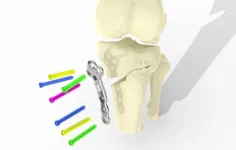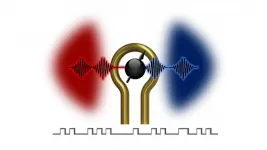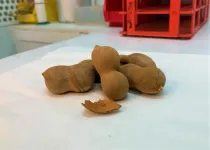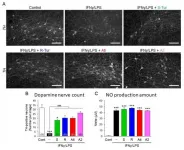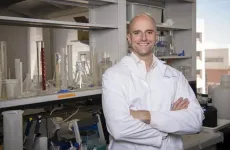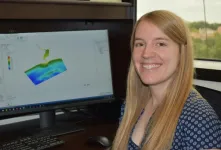(Press-News.org) Pioneering 'printed metal' procedure to create bespoke treatment for early knee osteoarthritis set to be trialled in the UK following MHRA approval.
World's first 3D printed high tibial osteotomy (HTO) device and procedure developed at University of Bath given approval for UK trials
Bespoke titanium alloy HTO implants that fit perfectly are designed to reduce discomfort for knee osteoarthritis patients
Sophisticated 3D scanning aims to make surgery quicker and safer
New TOKA process could make earlier intervention possible - saving patients decades of pain before surgery becomes viable
Intro
A groundbreaking new treatment that uses 3D printed implants and that could bring relief to tens of thousands of knee osteoarthritis sufferers has received approval to be trialled in UK patients, following a virtual "in-silico" trial that demonstrated its safety.
The personalised early knee osteoarthritis treatment, developed by engineers at the University of Bath's Centre for Therapeutic Innovation (CTI), uses state of the art 3D metal printing technology to make personalised medical-grade titanium-alloy plates that perfectly fit every patient.
The TOKA (Tailored Osteotomy for Knee Alignment) treatment improves the operative procedure and fit of high-tibial osteotomy (HTO) plates used to realign a patient's knee, making them more stable, comfortable and better able to bear weight than existing generic plates. The technique also simplifies HTO surgery, making operations quicker and therefore safer.
The HTO plates have already been safety tested virtually, in a computer-based trial using CT scan data from 28 patients. The in-silico clinical trial, the first in the world to demonstrate the safety of an orthopaedic device, modelled the stresses that would be exerted on the bespoke plates and showed that they would be comparable in safety to the standard treatment.
Professor Richie Gill, from the Centre for Therapeutic Innovation, says: "Knee osteoarthritis is a major health, social and economic issue and does not receive as much attention as it should. A quarter of women over 45 have it, and about 15 percent of men, so it's a significant burden that many live with.
"Knee replacement is only useful for end-stage osteoarthritis, so you can be in pain and have to live with a disability for a long time, potentially decades, before it's possible. We hope that the new TOKA process we've developed will change that."
Knee osteoarthritis patients undergoing TOKA will undergo a 3D CT scan of their knee, before a personalised 3D printed surgical guide and plate, both shaped to their tibia (shin) bone is created. The surgical guide simplifies the surgery, and is designed to improve surgical accuracy.
The process also sees the first implementation of 3D printed screw threads into the HTO plates, meaning they can be optimally positioned to help secure them against the bone.
Trials to begin once clinical centres reopen for elective surgery
When clinical centres return to carrying out elective surgery, expected later this year, the trials will begin. Hospitals in Bath, Bristol, Exeter and Cardiff will take part in a randomised control trial to compare patient outcomes with an existing generic HTO procedure.
Tests of the TOKA technique have already begun in Italy, where so far 25 patients received new personalised HTO plates as part of a trial at the Rizzoli Institute in Bologna.
High Tibial Osteotomy (HTO) surgery realigns the knee joint by making a cut to the tibia (shin bone) and opening a small gap, which needs to be stabilised by a metal plate. This realignment moves the loading to a less 'worn' part of the knee. Patient outcomes depend on how accurately the cut is made and the gap opened.
Prof Gill adds: "The HTO surgery has a long clinical history and it has very good results if done accurately. The difficulty surgeons have is achieving high accuracy, which is why we have created the TOKA method, which starts with a CT scan and digital plan.
"3D printing the custom knee implant and doing the scanning before operating means surgeons will know exactly what they'll see before operating and where the implant will go."
"In addition to a surgeon being able to precisely plan an operation, a surgical guide (or jig) and a plate implant, each personalised to the patient, can be 3D printed automatically based on the scanning data.
"Importantly this type of treatment relieves the symptoms of knee osteoarthritis while preserving the natural joint."
The pre-planning element greatly simplifies surgery and could cut the time on the operating table from two hours to around 30 minutes.
The work to date and UK trial is supported and funded by Versus Arthritis UK. The in silico trial has been published in Communications Medicine.
INFORMATION:
Many of us swing through gates every day -- points of entry and exit to a space like a garden, park or subway. Electronics have gates too. These control the flow of information from one place to another by means of an electrical signal. Unlike a garden gate, these gates require control of their opening and closing many times faster than the blink of an eye.
Scientists at the U.S. Department of Energy's (DOE) Argonne National Laboratory and the University of Chicago's Pritzker School of Molecular Engineering have devised a unique means of achieving effective gate operation with a form of information processing called electromagnonics. Their pivotal discovery allows real-time control of information transfer between microwave photons and magnons. And it could result in a new generation ...
An important new study by researchers at the U.S. Department of Energy's (DOE) Argonne National Laboratory has yielded critical fresh insights into the lithium production process and how it relates to long-term environmental sustainability, particularly in the area of transportation with batteries and electric vehicles.
The paper, "Energy, Greenhouse Gas, and Water Life Cycle Analysis of Lithium Carbonate and Lithium Hydroxide Monohydrate from Brine and Ore Resources and Their Use in Lithium Ion Battery Cathodes and Lithium Ion Batteries," in the journal ...
Prof. PAN Jianwei and Prof. ZHANG Jun from University of Science of Technology of China (USTC) of the Chinese Academy of Sciences, collaborating with Prof. CHU Tao's group from Zhejiang University, realized the fastest and miniaturized real-time quantum random number generator (QRNG) with the record-breaking output rate of 18.8 Gbps by combing a state-of-the-art photonic integrated chip with the optimized real-time post processing. The study was published in Applied Physics Letters on June 29.
Random number exists in many fields such as information security and cryptology industries. Different from other random number generators, QRNG, as the key part in quantum communication system, embraces the characteristics ...
Prof. DU Jiangfeng, Prof. RONG Xing, and their colleagues from the Key Laboratory of Micromagnetic Resonance, University of Science and Technology of China (USTC) of the Chinese Academy of Sciences (CAS), set the most stringent laboratory constraint on the exotic spin- and velocity-dependent interaction at the micrometer scale. This study was published in Physical Review Letters.
The search for dark matter, dark energy, and extra forces is important for the understanding of the existence of the matter that accounts for about a quarter of the universe, but little progress has been made. It is necessary to theoretically and experimentally find particles outside the Standard Model, a tradition ...
Shells of tamarind, a tropical fruit consumed worldwide, are discarded during food production. As they are bulky, tamarind shells take up a considerable amount of space in landfills where they are disposed as agricultural waste.
However, a team of international scientists led by Nanyang Technological University, Singapore (NTU Singapore) has found a way to deal with the problem. By processing the tamarind shells which are rich in carbon, the scientists converted the waste material into carbon nanosheets, which are a key component of supercapacitors - energy storage devices that are used in automobiles, buses, electric vehicles, trains, and elevators.
The study reflects ...
Osaka, Japan - When things get too much, we're often advised to "take a load off," but when it comes to bone maintenance, doing the opposite can be a good thing. Researchers from Japan have discovered some key mechanisms of how physical load stimulates bone growth.
In a study published July 13, 2021 at 11 a.m. ET in Cell Reports, researchers from the National Cerebral and Cardiovascular Center Research Institute have revealed that the expression of the peptide osteocrin (OSTN) is influenced by load - decreasing when load is reduced, and increasing when it is added.
Bones and skeletal muscles are strengthened by the load associated with exercise, preventing bone and muscle atrophy, and maintaining bone and muscle strength is important for maintaining physical activity. ...
Researchers from Kumamoto University, Japan have found that a component derived from turmeric essential oil, aromatic turmerone (ar-turmerone), and its derivatives act directly on dopaminergic nerves to create a neuroprotective effect on tissue cultures of a Parkinson's disease model. This appears to be due to enhanced cellular antioxidant potency from the activation of Nrf2. The researchers believe that the ar-turmerone derivatives identified in this study can be used as new therapeutic agents for Parkinson's disease.
Parkinson's disease is a neurodegenerative disease caused by the ...
When it comes to the medicinal and therapeutic properties of Cannabis sativa, an unsolved mystery is whether there exists an "entourage effect," whereby the pain-relieving effects of the plant as a whole are greater than any of its individual parts. New research from the University of Arizona Health Sciences has found evidence that favors the entourage effect theory and positions Cannabis terpenes, the part of the plant that provides flavor and aroma, as a promising new target for pain therapies that would require lower doses and produce fewer side effects.
"A lot of people are taking cannabis and cannabinoids for pain," said lead researcher John Streicher, PhD, a member ...
An associate professor of marketing at The University of Texas at Arlington says digital avatars can replace a sales force and customer service employees at a fraction of the cost.
In this context, avatars are typically computer-generated representations of people. UTA Associate Professor Fred Miao says they can fill the void in interactive assistance that a majority of shoppers says they want.
"An Accenture survey of online shoppers shows that 62% never completed their purchases because there was no real-time customer service or support. That Accenture survey also shows that 90% of those shoppers wanted some sort of interactive assistance during the shopping process," said Miao, faculty fellow of the John Merrill Endowed Professorship ...
Sea-level rise threatens to produce more frequent and severe flooding in coastal regions and is expected to cause trillions of dollars in damages globally if no action is taken to mitigate the issue. However, communities trying to fight sea-level rise could inadvertently make flooding worse for their neighbors, according to a new study from researchers at The University of Texas at Arlington and the Stanford Natural Capital Project published in Proceedings of the National Academy of Sciences.
Michelle Hummel, an assistant professor of civil engineering at UTA, was lead author of the report, which shows how seawalls constructed along the San Francisco Bay shoreline ...
